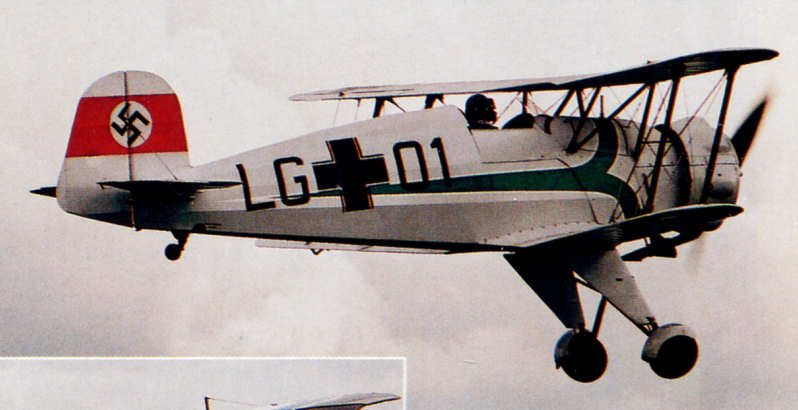Bucker Bu 133 Jungmeister
Заказов на Bu 131 Jungmann было столько, что вскоре завод в Йохэнништале перестал с ними справляться. Новый завод построили в Рангсдорфе, а компания "Bucker" приступила к проектированию одноместного учебного самолета ДальшеMore>>>
на базе Bu 131. Конструкцию и компоновку Bu 133 Jungmeister унаследовал от своего предшественника, но отличался меньшими размерами и двигателем Hirth НМ 6 мощностью 135 л.с. Уменьшение размеров в сочетании с увеличением мощности двигателя положительно отразилось на летных качествах самолета. По результатам испытаний машину рекомендовали к запуску в серийное производство как самолет повышенной подготовки летчиков и самолет первоначального обучения воздушному бою. Первый серийный вариант обозначался Bu 133A. Количество самолетов, построенных для Люфтваффе, точно не известно. Порядка 50 машин собрала фирма "Dornier-Werke" в Швейцарии для швейцарских ВВС, примерно столько же - фирма CASA для испанских ВВС.
Варианты
Bu 133B Jungmeister: обозначение самолетов, строившихся по лицензии, с двигателями Hirth НМ 506 мощностью 160 л. с. (119 кВт)
Bu 13ЗС Jungmeister: самый массовый серийный вариант со звездообразным мотором Siemens Sh 14A-4
ТАКТИКО-ТЕХНИЧЕСКИЕ ХАРАКТЕРИСТИКИ
Bucker Bu 133C Jungmeister
Тип: одноместный самолет повышенной подготовки летчиков и пилотажный самолет
Силовая установка: один звездообразный мотор воздушного охлаждения Siemens Sh 14A-4 мощностью 160 л. с. (119 кВт)
Летные характеристики: максимальная скорость на уровне моря 220 км/ч; крейсерская скорость на оптимальной высоте 200 км/ч; время набора высоты 1000 м - 2 мин 48 с; практический потолок 4500 м; дальность 500 км
Масса: пустого 425 кг; максимальная взлетная 585 кг
Размеры: размах крыла 6,60 м; длина 6,00 м; высота 2,20 м; площадь крыла 12,00 м2
Учебный биплан Jungmeister вернули в летное состояние после аварии двигателя в 1995 году и продали коллекционеру из США.
Bucker BU 133 Jungmeister.
FIO operates no fewer than four two-seater Bucker 133 Jungmann biplanes, as welt as single Bucker 131 Jungmeister (foreground).
SOLO TRAINER: A climb of 3,280 ft. in 3 min. and a top speed of 142 m.p.h. are achieved by this new German single-seater trainer, the Bucker Bu.133. The engine is a 140 h.p. Hirth.
A GERMAN SINGLE-SEAT TRAINER, the Bucker Jungmeister. Built on rather similar lines to the Bucker Jungman described in Flight of May 28, it is fitted with a more powerful engine - the 140 h.p. six-cylinder Hirth - and has a top speed of 143 m.p.h. The cruising speed is 124 m.p.h. and its landing speed 50 m.p.h. The makers are Bucker-Flugzeugbau G.m.b.H., Rangsdorf bei Berlin.
The first prototype of the Bucker Bu 133 Jungmeister powered by a Hirth HM 6 air-cooled engine.
The Bucker Bu 133 Jungmeister Single-seat Advanced Training Biplane (160 h.p. Siemens Sh 14 engine).
The new Focke-Wulf twin-engined trainer with the little Bucker Jungmeister - a type used for much of the aerobatic work during the Zurich meeting.
JUNGMEISTERFUL AEROBATICS: A Bucker test pilot, Arthur Benitz, has been touring South America with a Jungmeister and a Jungmann, and has given some 85 demonstrations. This lively aerial impression may be regarded from almost any angle.
The Bucker "Jungmeister" Single-seat Training Biplane (160 h.p. Siemens Sh.14A engine).
FLICK ROLL: Rarely have we seen a photograph which so adequately conveys the true aerobatic flying impression as this or a Bucker Jungmeister which, according to the caption sent with it, is in the act of starting one of the machine's characteristic flick rolls.
The German Bucker Jungmeister (160 h.p. Siemens) is one of the world’s finest aerobatic machines.
В 1999 году самолет G-AYSJ базировался в Даксфорде, графство Кембриджшир, и выступал на различных авиашоу по всей Великобритании.
The late Manx Kelly upside down
LOW-DOWN TRICK: Count Hagenburg, who won the International Competition for inverted flying at Zurich in 1936, goes into training for this year's event, for which he is a hot favourite. His mount is a Bucker Jungmeister with 160 h.p. Siemens engine. The photograph is not a faked one.
Finale: Herr Wendel (inset) winds up his demonstration with the Bucker Jungmeister with a high-speed inverted passage across the aerodrome at zero altitude. When this picture was taken he was climbing to avoid the Short Scion on the left; on his previous passage the Bucker's tail fin positively stroked the grass - to the terrified joy of the onlookers.
The Bucker Jungmeister belonging to John Hickman of Beeville, Texas, photographed at Blakesburg in August 1975.
ECHOS FROM EVERE: German Bucker Jungmeister aerobatic trainers of the unit which demonstrated at Evere.
Photograph features Mike Stowe's Jungmeister taking-off from Old Warden on August 30, 1981.
The “Luftwaffe” trainer trio is working up. Left to right, are Jungmeister G-AXIH, Jungmann G-BUCK and Steiglitz G-BAAY
Roger Reeves’s yellow Bucker Jungmeister G-BUKK outside Skysport Engineering’s hangar near Sandy, Bedfordshire on August 21, 1989 after an overhaul. Sky sport’s newly-acquired Miles Falcon Major G-AEEG is just visible in the hangar.
Bucker Bu 133 Jungmeister HB-MIE seen last year over Germany.
Shortly after arrival in England, at Redhill on October 26, 1969
Bucker Bu.133 Jungmeister.
Alex Papana of the Roumanian Air Force with the Bucker Jungmeister aerobatic trainer was flown to the U.S.A. in the Zeppelin Hindenburg for demonstration at the National Air Races.
Mr. Beverly Howard, President of the Hawthorne School of Aeronautics, with one of the few Bucker Jungmeisters in the United States.
A Spanish-built Bucker Bu 133C Jungmeister (C.A.S.A. ES-1) was seen in England th is summer at the aerobatic championship rally.
Seen at Blackbushe, one of Bob Thompson's two Pitts S-2A Specials, G-BECM, of the new "Jubilee Duo" team, and Mike Stow's Bucker Jungmeister G-AXNI and Harvard G-AZSC
A "Bucker-Jungmeister" plane equipped with an Sh 14A4 Aero-Engine being transported by Zeppelin to America. There the Sh 14A4 achieved further successes.
Count von Hagenburg (in cockpit) borrowed an aerobatic Bucker from Capt. Alex. Papana.
Аэроклуб Каунаса. На переднем плане видны четыре планера разных типов (в основном германского производства), за ними самолеты Бюккер-133 и Пайпер «Кэб», 1939 г.
"Jungmeister" training plane for advanced pupils.
